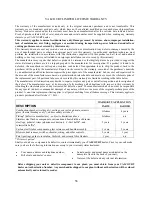
46
6.0 OPERATING THE FP7-LM ANTOINETTE WOOD FIREPLACE
Inside the firebox of your unit, you will find the handle that allows you to open the glass door of
your fireplace. Simply insert into the opening provided for this purpose at the bottom left of the
glass door. This handle is removable so you can take it off at your convenience.
6.1 First
Fires
The fresh paint on your fireplace needs to be cured to preserve its quality. Once the fuel load is
properly ignited, only burn small fires in your fireplace for the first four hours of operation. Make
sure that your exhaust damper and air intake control are in the open position. Make sure that there
is enough air circulation while curing the fireplace. Open one or more windows as necessary.
The odours can be smelled during the 3 or 4 first fires.
6.2
Building a Fire
To start a fire, place several crumpled up balls of newspaper in the firebox behind the andiron.
Place small dry pieces of kindling on top of the paper, criss-crossing the kindling so that there are
air spaces in between. Open the exhaust damper fully and light the newspaper. Once the
newspaper and the kindling are well ignited, you may close the glass door for a few minutes so
that the firebox and chimney of your fireplace can heat up enough for optimal operation. When
this heating period is done and the kindling fire is well established, you can operate the fireplace
with the firescreen or the glass door depending on your preference and add cordwood as needed.
The unit will burn best with 2-3 pieces of cordwood spaced 1 to 2 inches apart and allowing air to
get under the fuel. Criss-crossing or arranging the fuel so that air can get underneath, will help the
fire to get started easily.
CAUTION: THE EXHAUST DAMPER AND THE AIR INTAKE CONTROL MUST BE
KEPT FULLY OPEN UNTIL THE FIREPLACE HAS COOLED DOWN FOR A FEW
HOURS.
Summary of Contents for FP-7-LM ANTOINETTE
Page 16: ...16 Figure 13 Figure 14...
Page 17: ...17 Figure 15...
Page 18: ...18 Figure 16...
Page 19: ...19 Figure 17 Insulated chase construction...
Page 20: ...20 Figure 18 Spacers must be installed...
Page 22: ...22 Facing With the Narrow Overlap Figure 19...
Page 23: ...23 Facing With the Masonry Trim Figure 20...
Page 26: ...26 Figure 23...
Page 28: ...28 Figure 24 Figure 25...
Page 39: ...39 EXAMPLE OF TYPICAL CHIMNEY INSTALLATION Figure 33...
Page 41: ...41 Figure 34 Figure 35...











































